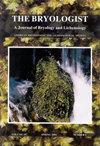Common Mosses, Liverworts, and Lichens of Ohio: A Visual Guide – A field companion for the cryptogam naturalist
IF 1.5
4区 生物学
Q4 PLANT SCIENCES
引用次数: 0
Abstract
Robert Klips’ book, Common Mosses, Liverworts, and Lichens of Ohio: A Visual Guide, is a product of a collaborative effort amongst the bryologists and lichenologists of the Ohio Moss & Lichen Association (OMLA). Though Klips is the only author of the book, OMLA members contributed some illustrations, feedback, and supplying poetry folded between the chapters. The book is intended primarily for aspirant cryptogam naturalists and aims to inspire curiosity in readers. By providing a ‘‘starter set’’ of cryptogams, this book pushes them to ‘‘dig deeper using microscopes and more technical manuals.’’ The spectacular macro-photography truly captures the complexity of the various organisms included, and the ecological roles they serve. Klips uses these photos to explain technical terms and concepts, highlighting key differences in leaf morphology, habitat utilization, reproductive structures such as sporangia and gametangia, and other details pertinent to cryptogram identification. The first chapter of the book provides an overview of mosses, liverworts, hornworts, and lichens. In this section, Klips emphasizes the ecology of bryophytes and lichens, describing how to find them, where they grow and how they survive, and their importance in the ecology of other organisms. Book chapters dedicated to the mosses are organized by morphology and include treatments for 106 of the more than 400 species of mosses in Ohio (Andreas 2011). The moss species accounts are divided into ten chapters – four chapters dedicated to acrocarps (the ‘‘cushion mosses’’), three chapters dedicated to pleurocarps (the ‘‘carpet mosses’’) and three chapters dedicated to the ‘‘weird ones’’ that are so different from the rest that they do not fall into either category. The sections are further broken down by leaf features. The acrocarps are separated by leaf shape (hairlike, lance-shaped, tongue-shaped, broad), the pleurocarps are separated by costa and leaf shape (sickle-shape, costate, ecostate), and the others are split into three groups (Flat Fissidens and Friends, Haircap Mosses, Sphagnum Mosses). Ultimately, Klips spends one chapter divided into ten sections discussing how to identify mosses. Thirty-one taxonomic treatments of the approximate 100 liverwort species that have been recorded in Ohio are included in this book (OMLA). Three species of hornworts are addressed in this section, though they are not included in the taxonomic treatments. The liverworts are divided into fourteen different groups representing ‘‘growth form categories helpful in identification,’’ such as ‘‘leafy liverworts with toothed leaves and succubous insertion,’’ which is consistent with grouping schemas in scientific literature. According to the OMLA website, there are more than 200 species of lichen in Ohio, 101 of which are included in the book (OMLA). Like the mosses, Klips takes great care to discuss the procedures required to accurately俄亥俄州常见的苔藓、苔类和地衣:视觉指南——密码学博物学家的野外伴侣
Robert Klips的书《俄亥俄州的常见苔藓、Liverworts和地衣:视觉指南》是俄亥俄州苔藓和地衣协会(OMLA)苔藓学家和地衣学家合作的成果。尽管Klips是这本书的唯一作者,但OMLA成员提供了一些插图、反馈,并在章节之间提供了诗歌。这本书主要面向有抱负的隐gam博物学家,旨在激发读者的好奇心。这本书提供了一套“最新”的密码游戏,推动他们“使用显微镜和更多技术手册进行更深入的研究”壮观的微距摄影真实地捕捉到了各种生物的复杂性,以及它们所扮演的生态角色。Klips利用这些照片解释了技术术语和概念,强调了叶片形态、栖息地利用、繁殖结构(如孢子囊和配子囊)以及其他与密码识别相关的细节方面的关键差异。本书的第一章概述了苔藓、苔类、角类和地衣。在本节中,Klips强调了苔藓植物和地衣的生态学,描述了如何找到它们,它们在哪里生长,如何生存,以及它们在其他生物生态学中的重要性。专门介绍苔藓的书籍章节按形态学组织,包括对俄亥俄州400多种苔藓中106种的处理(Andreas 2011)。苔藓物种的记述分为十章——四章专门介绍肢端苔藓(“枕形苔藓”),三章专门介绍胸果苔藓(“腕状苔藓”)和三章专门讨论“背部苔藓”,它们与其他章节截然不同,不属于任何一类。这些部分按叶特征进一步细分。肩果按叶形(发状、矛状、舌状、宽)分开,胸果按肋和叶形(镰刀形、肋状、生态状)分开,其他分为三组(扁裂和朋友、帽苔、泥炭藓)。最后,Klips花了一章时间,分为十节,讨论如何识别苔藓。本书(OMLA)收录了俄亥俄州记录的大约100种苔草的31种分类处理方法。本节介绍了三种角虫,尽管它们不包括在分类学处理中。苔类植物分为14个不同的类群,代表“有助于识别的生长形态类别”,如“带齿叶和肉质插入的叶苔类植物”,这与科学文献中的分组模式一致。根据OMLA网站,俄亥俄州有200多种地衣,其中101种被收录在该书(OMLA)中。像苔藓一样,Klips非常谨慎地讨论准确
本文章由计算机程序翻译,如有差异,请以英文原文为准。
求助全文
约1分钟内获得全文
求助全文
来源期刊

Bryologist
生物-植物科学
CiteScore
2.40
自引率
11.10%
发文量
40
审稿时长
>12 weeks
期刊介绍:
The Bryologist is an international journal devoted to all aspects of bryology and lichenology, and we welcome reviews, research papers and short communications from all members of American Bryological and Lichenological Society (ABLS). We also publish lists of current literature, book reviews and news items about members and event. All back issues of the journal are maintained electronically. The first issue of The Bryologist was published in 1898, with the formation of the Society.
Author instructions are available from the journal website and the manuscript submission site, each of which is listed at the ABLS.org website.
All submissions to the journal are subject to at least two peer reviews, and both the reviews and the identities of reviewers are treated confidentially. Reviewers are asked to acknowledge possible conflicts of interest and to provide strictly objective assessments of the suitability and scholarly merit of the submissions under review.
 求助内容:
求助内容: 应助结果提醒方式:
应助结果提醒方式:


